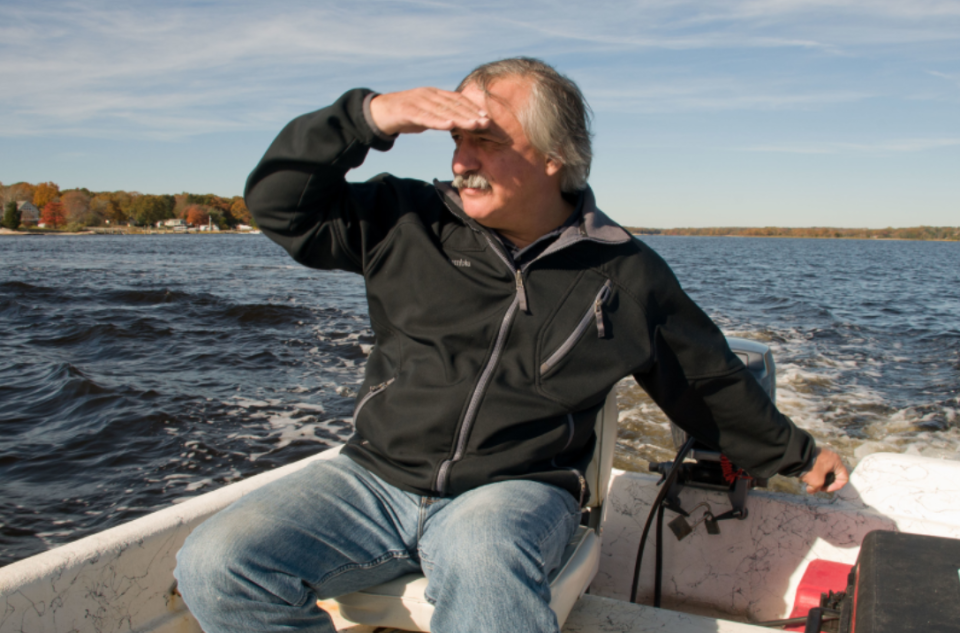UMass Dartmouth gets funding to build new Biodegradable Plastics Lab
DARTMOUTH — It's easy to reach the level of despair when it comes to the world's plastics problem.
A 2017 study published in the online journal Science Advances revealed that only 9% of the plastics produced since 1950 have been recycled. Nearly 80% ended up in landfills or in the natural world and 12% was incinerated the study found.
While the fate of bottles, straws and bags generate most of the publicity, textiles are a significant part of the problem. Plastics are a major component of textile manufacturing.
EPA statistics show that the amount of textiles produced in the U.S. grew from 1.76 million tons in 1960 to over 17 million tons in 2018. But only 2.5 million tons were recycled that year and 11.3 million tons ended up in landfills.
Michael Joyce, CEO of PrimaLoft, which its website says supplies synthetic fabric and fibers to 900 clothing manufacturers globally, including major brands such as Nike, Under Armour and Eastern Mountain Sports, decided that while he couldn't control where the clothing and other products made using his synthetic material ended up, he could manufacture it in a way that reduced the level of harm.

Back in 2014, PrimaLoft was working with a Norwegian clothing company that wanted it's product to stand up to the wear and tear of an outdoor lifestyle, but when discarded the material would break down naturally into environmentally friendly compounds.
The Norwegian company's request led to the development of a product line in 2018 that, according to testing under standards set by the American Society for Testing and Materials (ASTM), broke down into elemental components in less than two years under lab conditions that simulated a landfill. Testing also showed that using a chemical process converted their product into virgin material that could be used to create new plastic.
What we know: Pilgrim nuclear plant may release 1M gallons of radioactive water into bay
Joyce is a 1985 graduate of the University of Massachusetts Dartmouth's textile technology program, and the development of biodegradable fibers inspired him to approach officials at his alma mater about building a lab that would not only test products claiming to be biodegradable, but could investigate other ways to reduce the environmental impact of plastic.
"We (PrimaLoft) don't have testing facilities, and the one's we use don't do any research," Joyce, who lives in Chatham, said in recent telephone interview. He thought the UMass Dartmouth School for Marine Science and Technology (SMAST) would be a perfect place for such a lab, especially since it's waterfront location allowed for testing to expand into the marine environment.
Money donated to establish UMass Dartmouth Biodegradable Plastics Lab
Earlier this month, PrimaLoft gave $350,000 to UMass Dartmouth to establish the lab. It was the most significant part of $1 million in funds, labor, and staffing from other private partners, as well as the University of Massachusetts and the Marine Biological Laboratory in Woods Hole. The donations triggered a $739,936 matching grant from the Massachusetts Technology Collaborative to establish the Biodegradable Plastics Lab at SMAST.
Policy: Sandwich overturns single-use plastic water bottle ban, personal watercraft debated
"It wouldn't have been possible without Mike Joyce and PrimaLoft," said Jean VanderGheynst, dean of the UMass Dartmouth School of Engineering and SMAST interim dean. "He felt, given the strength of the engineering (program) and SMAST, that this was a good place to do it."

Ramprasad Balasubramanian, vice provost for Research and Academic Affairs at UMass Dartmouth, said the university had already been exploring building a marine lab to support research for the emerging offshore wind industry.
"This really took on a life of its own because the more people I talked to, from NOAA to the Office of Naval Research, talked about the importance of knowing what was going to happen to the things we were basically throwing into the ocean," Balasubramanian said.
A 2015 University of Georgia report published in the online journal Science estimated that 192 countries produced 275 million metric tons of plastic waste in 2010 and that between 4.8 to 12.7 million metric tons a year enter the ocean, the equivalent of two garbage trucks of trash every minute. While the five large ocean gyres of plastic trash — large systems of rotating ocean currents — get a lot of media attention, most of the oceans' plastic is hidden in smaller particles known as microplastic that hang like a curtain in the upper ocean.
Plastic is highly resistant to biodegrading and in nature it tends to break into smaller and smaller pieces over long periods of time. Microplastics are pieces smaller than a quarter inch.
Climate: Arctic researchers want to state their case before international climate change policy makers
A 2011 Australian study published in a journal of the American Chemical Society found that 85% of the plastic found on shorelines was microfibers, the polyester and acrylic fibers used in clothing. According to data collected on the statistical modeling website Statista, worldwide plastics production has increased from 1.5 million metric tons in 1950 to 245 million metric tons in 2008 and continued a steady climb to 367 million metric tons in 2020.

A 2021 Kyushu University study estimated there were 24 trillion pieces of microplastics in the world's upper oceans weighing as much as 578,000 tons. These plastics have entered the oceanic food chain and ultimately into our diet.
"This is in the forefront of everyone that is operating in the marine coastal region," Balasubramanian said. "The largest pollutant in the ocean right now is microplastics."
How biodegradable plastic decomposes in nature
VanderGheynst is an engineer focused on how plant biomass breaks down in the environment. Think of the backyard compost pile where a multitude of microorganisms working on breaking down cellulose, the chain of sugar molecules bound together by an electron-sharing mechanism that give plants structure. These chains are broken down using specialized enzymes that dissolve that bond and allow these microorganisms to digest the sugar molecules.
That decomposition extends to some textiles. A cotton T-shirt, VanderGheynst said, is actually composed of cellulose that is crystalline.
"It's just a chain of sugar," she said. When it's tossed into a landfill, the T-shirt is attacked by these microorganisms and their specialized enzymes begin breaking those bonds and digesting the clothing. The ultimate end-product of decomposition of plant matter is CO2 and water, VanderGheynst said, and a cotton T-shirt in a compost pile wouldn't be recognizable after six months.
Under the sea: Researchers from WHOI's submarine Alvin find an Octopus Garden
But plastics, including synthetic fibers, have long polymer chains that don't exist in nature and microorganisms don't have the specialized enzymes to dissolve the bonds between individual monomers, and reduce them into components that can be used by other organisms.
A cow, for instance, has bacteria in its gut that have the enzymes to break down grass cellulose, but humans don't, and our digestive system extracts very little from grazing.
The ultraviolet rays in sunlight can break plastic polymer chains, but it takes a long time and depends on the material being exposed to light. According to research cited on the World Wildlife Fund website, a plastic bag takes 20 years, a plastic cup 30 years and diaper and a plastic toothbrush take 500 years to decompose. Most plastic doesn't decompose at all, but simply breaks into microplastics.
Joyce said the biodegradable fibers in PrimaLoft Bio, made from 100% recycled plastic, are designed to degrade in marine environments and landfills. They also can be broken down chemically into virgin stock that can be made into new products.
'The ocean is alive': After $50M upgrade, research sub Alvin can reach 99% of ocean floor
Joyce said PrimaLoft added sugars to it's plastic polymers that attract microorganisms with enzymes to dissolve the bonds between molecules until it is reduced to CO2, methane and water, with a small amount of compostable carbon left behind. According the company website, testing by independent labs under ASTM standards showed 93.8% biodegradation in 646 days in an accelerated landfill environment and 74.3% biodegradation in 889 days under an accelerated marine/ocean environment.
Limits to plastic decomposition
But the PrimaLoft website also acknowledges that California does not allow products to carry labels such as biodegradable, degradable or decomposable. In 2011, California's attorney general filed a lawsuit that caused three companies to remove advertising claiming their plastic water bottles were 100% biodegradable and recyclable. California's CalRecycle website says that environmental marketing claims need to be "substantiated by competent and reliable scientific evidence."
Joyce said that California is behind the times, that it has not revisited a science that has evolved over the past decade.
"The idea of making plastics that can biodegrade has been around a long time, and there are certain plastics that can do this," said Margaret Sobkowicz-Kline, an associate professor in the Plastics Engineering Department at the University of Massachusetts Lowell.
The problem with widespread acceptance and use of biodegradable plastics is that their rate of decomposition depends on environmental conditions. Temperature, sunlight, oxygen, moisture, the type of microorganisms present, all critical to the natural decomposition process, can vary widely between landfills, the marine environment, and wastewater treatment plants.
That is the importance of testing facilities in recreating those conditions and in researching the materials that will biodegrade under a wide range of variables.
"It's a biology problem, but the production and design of new plastics is an engineering problem," Brian Howes, a chancellor and professor of estuarine and ocean science at SMAST, explaining that both the engineering and biology departments would be involved.

Part of the lab's mission, Howes said, would be to certify that environmental marketing claims are scientifically valid.
"They are developing new fibers and materials all the time," Howes said. "But now they have to test them. Do they work?"
Computer modeling and chemical predictions of what will happen have to be verified, he said, by testing the product in the lab under ASTM standards in vessels that mimic conditions in landfills, salt and freshwater environments and wastewater treatment plants.
SMAST's location near a wastewater treatment plant and on the waterfront will provide the environmental materials for testing for those two ecosystems, and a separate instrument will grow the bacteria to simulate a landfill. Plastic samples will be placed in 140 bioreactors that vary in size from a yogurt cup to a two liter bottle.
These digestors compress the time frame for biodegradation into 60 to 90 days. Decomposition is measured using gases emitted during the process that flow past a sensor that identifies and quantifies compounds.
Textile industry seems engaged in biodegradable plastic research
"Our goal is to have them (plastics) break down rather than break up (into microplastic)," Howe said.
But, not while you're wearing it, of course. Howes said ideally the plastic fabric and fibers completely biodegrade within three years. He thinks the textile industry is engaged.
"From an industry perspective they want biodegradable stuff, (they) know that will capture people's attention," said Howes. He said that the UMass lab will be sharing its results with other labs in an effort to cross-check results.
The testing will not only include fibers from textile manufacturers but other plastics such as fishing line and nets that make up a large amount of plastic pollution in the ocean, Howes said. While a majority of the testing will be done on industry samples, a portion of the lab space will be used for research. The lab is on track to open in March 2022, VanderGheynst said
"The equipment is coming in and being assembled," Howes said, although there are some supply chain issues.
"It's pretty unusual to find a facility that can do standardized biodegradation testing, that have ASTM standards for different types of biodegradation in soil, wastewater and marine conditions," said Sobkowicz-Kline. "We do a lot of work with plastic sustainability and this facility will support, complement and augment our research."
Contact Doug Fraser at dfraser@capecodonline.com. Follow him on Twitter: @dougfrasercct.
This article originally appeared on Cape Cod Times: New UMass lab will test, certify and research biodegradable plastics

